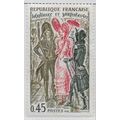Costume- Crna Trava SERBIA national dress 1970s
- Condition : Used
- Dispatch : 2 Days
- Brand : None
- ID# : 35389776
- Quantity : 1 item
- Views : 8665
- Location : United Kingdom

- Seller : justthebook (+1704)
- Barcode : None
- Start : Sat 27 Nov 2010 16:55:51 (EDT)
- Close : Run Until Sold
- Remain : Run Until Sold
Checks/Cheques
 for 1 item(s) edit
for 1 item(s) edit
Shipping Calculator
More Listings from This Seller view all
Seller's Description
- Postcard
- Picture / Image: National Costume from Crna Trava, Serbia
- Publisher: Foto Tehnika, Zagreb
- Postally used: yes
- Stamp: Yugoslavian stamp 0,50 definitive Zenica
- Postmark(s): illeg.
- Sent to: Connaught Road, Teddington, Middlesex, England
- Notes & Key words:
------------------------------------------------
Postage & Packing:
UK (incl. IOM, CI & BFPO): 99p
Europe: £1.60
Rest of world (inc. USA etc): £2.75
No additional charges for more than one postcard. You can buy as many postcards from me as you like and you will just pay the fee above once. (If buying postcards with other things such as books, please contact or wait for invoice before paying).
Payment Methods:
UK - PayPal, Cheque (from UK bank) or postal order
Outside UK: PayPal or Google Checkout ONLY please. NO non-UK currency checks or money orders (sorry).
NOTE: All postcards are sent in brand new stiffened envelopes which I have bought for the task. These are specially made to protect postcards and you may be able to re-use them. In addition there are other costs to sending so the above charge is not just for the stamp!
----------------------------------------------
Text from the free encyclopedia WIKIPEDIA may appear below to give a little background information:
*************
Traditional Serbian costumes, like any other traditional dress of a nation or culture, has been lost to the advent of urbanization, industrialization, and the growing market of international clothing trends. Nonetheless, the dress is still a pinnacle part of Serbian folk culture and, fitting with the attempts to preserve this folk culture, it was not uncommon to see rural women in traditional working costumes all the way up until the end of President Tito's term. Today, these costumes are still worn on national holidays and celebrations especially in rural areas. Features of Serbian dress include Opanak, a form of footwear dating back to the medieval Serb kingdoms.
Serbian costume is also known for the variety of textures and embroidery. The Jelek is a Waistcoat made from wool or velvet while women's jackets are lined with fur. The peony embroidery design often found on aprons, socks and elsewhere is colored bright red, symbolising the blood lost at the Battle of Kosovo. Montenegrin caps are traditional caps worn in Montenegro by Montenegrins and Serbs in Montenegro.
Traditional Serbian female dress consists of opanci, embroidered woolen socks that reached to the knees and nazuvice. Skirts were very varied, of plaited or gathered and embroidered linen, with tkanice serving as a belt. An important part of the costume were aprons (pregace) decorated with floral motifs. Shirts were in the shape of tunics, richly decorated with silver thread and cords was worn over the shirt. In some areas it was replaced by an upper sleeveless dress of red or blue cloth, knee-long, richly decorated and buttoned in front (zubun). Scarves and caps bordered with cords were worn as headdress. Girls also wore collars, or a string of gold coins around their throats, earrings, bracelets, and their caps were decorated with metal coins or flowers. Young people do not wear this kind of costume nowadays. It can be seen on elderly villagers, as tourist attraction, or in museums. From the 19th century on, Serbs have adopted the usual European way of dressing.
In medieval times, rulers, the nobility and senior churchmen brought many of their fabrics from Dubrovnik. The most common fabric for ordinary Serbs was sclavina or schiavina, a coarse woollen fabric. Linen was also made within Serbia while silk was grown at the Decani Monastery as well as near Prizren. Few secular garments have survived from the medieval period the most notable being the costume worn by Lazar Hrebeljanovic at the Battle of Kosovo. More decorated vestments have survived from the period.
Listing Information
| Listing Type | Gallery Listing |
| Listing ID# | 35389776 |
| Start Time | Sat 27 Nov 2010 16:55:51 (EDT) |
| Close Time | Run Until Sold |
| Starting Bid | Fixed Price (no bidding) |
| Item Condition | Used |
| Bids | 0 |
| Views | 8665 |
| Dispatch Time | 2 Days |
| Quantity | 1 |
| Location | United Kingdom |
| Auto Extend | No |


















